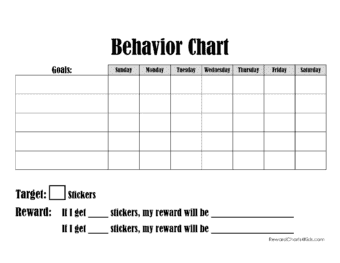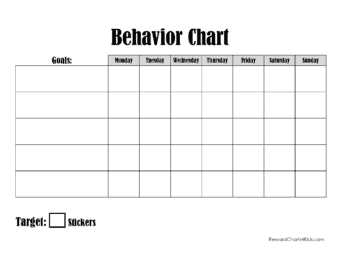ODD Behavior Chart
It is normal for children and teens to get angry at times. Anger is a part of life. Parents and teachers may begin to have concerns when negative behavior interferes with the normal functioning of a child and their relationship with others. However, oppositional defiant disorder (ODD) includes a frequent and ongoing pattern of anger, irritability, arguing and defiance toward parents and other authority figures (Mayo Clinic).
Please be aware that the information provided below is for general purposes only and should not be construed as medical advice, diagnosis, or treatment. For any medical concerns or advice, it is recommended to consult with a qualified healthcare professional.
What is oppositional defiant disorder?
The oppositional defiant disorder is a behavior disorder (source). A child that has this condition is more than just stubborn or strong willed. The child has a pattern of uncooperative and definite disorders. They may be hostile and try to annoy people in their lives including those that have authority such as a parent or a teacher. This defiance is more than just normal development. It is to the point when the daily life of the child is disrupted by their hostile behavior and mood.
What is an oppositional defiant disorder in children?
In children, oppositional defiant disorder will have a child refusing to comply with requests or authority. If a child is asked to do something even something simple they will refuse. The child will appear angry and in some cases, the reason is not obvious. The child will have trouble getting along with others. They may struggle to develop relationships with peers due to their anger and poor behavioral choices. A child with ODD often gets in trouble in school for refusing to follow the rules and arguing with the staff. At home, these children also refuse to follow rules and may be at odds with their parents.
ODD Symptoms
It can be hard to recognize if a child has ODD in the beginning. Over time the parents and others in the child’s life will need to track the behaviors. There are some things that can show signs of ODD.
If the child is angry and loses their temper often this can be a sign. If they are often resentful this is a concern. If the child seems to be angry all of the time ODD may be the cause.
Here are some more symptoms:
- Experiencing frequent outbursts of anger
- Engaging in frequent disagreements with adults
- Declining to comply with adult requests
- Consistently challenging rules and resisting adherence
- Engaging in behaviors intended to provoke or disturb others, including adults
- Holding others accountable for the child’s own misdeeds or errors
- Using harsh or unkind language
There are times when all children are defiant but those with ODD cannot seem to get along with others and their behavior is intended to be defiant. A child with ODD argues and refuses to comply with the request or rules from adults. They intentionally behave in ways to make people annoyed or upset. They do not take responsibility for their behavior and will blame their actions on others. These children are often spiteful.
In the beginning, the signs and symptoms of ODD may be shown in the home. Over time, they will carry over into other areas of the child’s life including school and any activities they may be involved in.
How to Deal with an ODD Child in the Classroom
Teachers are going to come in contact with children with ODD. They need to choose their instruction wisely to increase the chance of compliance. The classroom should be structured. A teacher can post the schedule so that the student knows what is coming next. They need to make a clear transition from one activity to the next. These students should be kept busy and they should not be allowed downtime. When the student does follow the classroom rules or complete the given task they need positive reinforcement. This can be something such as a good job or other types of praise. The teacher also needs to remain consistent. If the student breaks a rule they do not get their reward or praise. A teacher needs to avoid a power struggle. When possible the student should be given a choice of two desirable items. For example, a teacher can ask a student if they want to do their worksheet first or their reading. The teacher is still getting the student to complete the tasks but the student feels like they have some control and is more likely to comply.
ODD Behavior Chart for Students
A behavior chart is an effective way to track behaviors and determine if interventions are effective. When working with young people with ODD some behaviors will need to be tracked first. The teacher will need to work with the parents and other teachers to look at the behaviors that are the most disruptive. They should pick two to three behaviors at a time.
A point system can be used to track the behaviors. The school day can be broken into 15-minute increments. If the child complies with the directions and does not display the problem behaviors they can earn four points at that time with a possibility of earning 100 points during the school day. When the child earns their points they will have the chance to earn rewards. This may be something tangible such as candy or it can be something such as extra recess.
To begin the behavior chart the child should have to earn 80 out of 100 points in the target behavior areas. As the child complies this number can be increased. To help support the child during this time they should be given a lot of positive reinforcement including praise for compliance. The teacher and other staff also need to give the child some positive replacement behaviors. To get rid of the non-compliant behaviors the child needs to be given something positive to fill the void.
The behavior chart can be used in a home setting too. The parents can continue to use the behavior techniques from the school and carry them into the home. As the child complies they may earn things such as TV or computer time. The parent needs to be consistent and they cannot give in. If the child is pestering them for computer time and they did not earn it the parent cannot give in. This can be tough. While the behaviors are changing they may get worse. It is important to be consistent and firm. Over time the behavior will show improvement and the child will get closer to resuming normal functioning.
The following behavior charts are available in Word format so you can edit them to suit your requirements and the needs of the child.

Word | Editable PDF | Image
This behavior chart records a number of points (from 1 to 5) for each class period for each day of the week.

Word | Editable PDF | Image
This is similar to the chart on the left but it has space for a parent’s signature.

Word | Editable PDF | Image
Use this behavior chart to track specific behaviors each day (list them in the first column). You can also change the title to track periods of time if you prefer.

Word | Editable PDF | Image
This is similar to the chart on the left but it has space for a parent’s signature.

Word | Editable PDF | Image
This version has space for a parent’s signature to ensure that they are involved and updated.

Word | Editable PDF | Image


